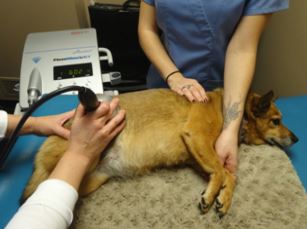The Not-So-Shocking Truth about Shockwave
By Colleen Lum LVT
What is shockwave?
Does it involve attaching clamps to my dog and sending electrical jolts through his body? NO! In fact, Shockwave Therapy (also known as Acoustic Compression Therapy or Extracoporeal Shockwave Therapy) actually involves the use of sound waves or acoustic waves. These sound waves meet at a focal point in the target tissue (muscle, joint, tendon, etc.) and produce an intense, extremely short duration pressure pulse that delivers therapeutic massage in areas difficult to reach by other methods. This therapeutic massage can help with managing chronic and acute pain as well as assist with healing.
What kind of conditions can ACT help with?
- Osteoarthritis
- Hip and elbow dysplasia
- Muscle repair (iliopsoas strain)
- Delayed healing of fractures
- Wound healing
- Tendonitis (biceps, supraspinatus)
- Sesamoiditis
- Chronic back pain
Treating with ACT
ACT works by creating a controlled inflammatory response that helps jump start the healing and pain relieving process. The day of and three days after an ACT treatment, patients should stop taking any prescribed NSAIDs (non-steroidal anti-inflammatory drugs) so they do not prevent the remodeling inflammation that we desire. At the end of those three days they may continue those medications as prescribed. Side effects are generally in frequent and may include reddening of the skin locally and/or minor soreness.
In the case of the PiezoWave Vet unit that we use here at Pawsitive Steps, our patients do not require anesthesia in order to be treated. The machine is quiet while in use, relatively pain free and we can gauge the patients’ response to the level at which we are treating.
There are however medical conditions in which we would avoid the use of ATC therapy such as over a neoplastic legion (cancer), thorax or abdomen, potential vascular thrombi (blood clots), or in the place of stabilization of fractures and traditional wound management (Kristin Kirkby 2013).
If you think your furry companion could benefit from shockwave therapy or you have any questions regarding shockwave, or canine rehabilitation in general, feel free to contact us!
Works Cited
Kristin Kirkby, D. P. (2013). Shockwave Therapy as a Treatment Option. Clinician’s Brief, 51-52.
Piezo Shockwave for Animals. (n.d.). Retrieved March 5, 2015, from Elvation: http://www.elvation.de/index.php/en/piezo-electric-shockwave/eswt- tpst/piezso-vet
